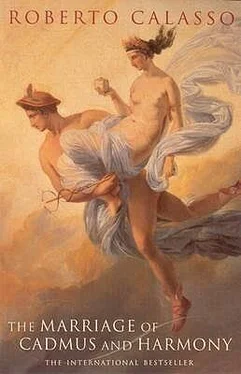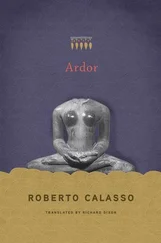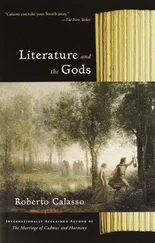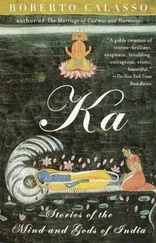Aeschylus, however, has a different vision of events. He describes the crown given to Prometheus as an antípoina , a “retribution,” which is also a ransom. Prometheus had earned his ransom by revealing to Zeus that, if he had a child with Thetis, it would overthrow him. Hence, having first deceived the god, Prometheus had then saved him. And now he was to remain among men and bring them a second revelation, after that of fire: the crown. From chain to crown: it was still a fetter of a kind; anything strong that grips us is a fetter. But now the fetter had been lightened; it became fragile and soft, gently encircling the head, for “all our feelings are in our heads.” What did that vegetable weave conceal, then, that was so precious? Perfection. It was the Greek gift par excellence, the goal this people always sought.
It would be a long time before crowns were being handed out at banquets. In the beginning, it was the idea of separation that was essential. Forerunner of the magic circle, the crown divided the world in two: there was the sacred fragment within the crown (sacrificial victim, spouse, or statue) and everything else outside. “Everything that belonged to the cult, whether people, animals, victims, or symbols, would be marked out by a crown or a band, as a sign of consecration, and often by both crown and band.” At this point the crown was “herald of the holy silence,” prelude to the sacrificial killing. But, having begun with this cult use, the Greeks developed the crown in a way all their own. The sacred is something that impregnates, it pours into the young girl, the animal, the statue, and fills them. Hence the sacred comes to partake of fullness, and fullness with perfection, since as Aristotle puts it, “we offer to the gods only that which is perfect and whole.” The Iliad speaks of “youths who filled [or crowned: epestépsanto ] the bowls with wine.” The crown was the rim of the goblet, the point at which fullness becomes excess. The crown was a mobile templum , bringing together election and danger. The perfect brings death upon itself, since one can’t have fullness without spillage, and what spills out is the excess that sacrifice claims for itself. “What is full, is perfect, and coronation signifies perfection of some kind.” So says Athenaeus. Animals for sacrifice would only be crowned once it was clear that they were perfect, “so as not to kill something that was not useful.”
At first the crown enclosed the sacred, separating it off from the profane world. In the end, it enclosed the perfect in its self-sufficient fullness. With a deft and unspoken shifting of contexts, the Greeks removed the crown from blood and sacrifice. They wanted it to celebrate what was perfect in its own right. From now on it would not form part of a ceremony that was acted out but would celebrate something that simply existed in itself. The crown is nothing less than the highest, the most exposed level of existence. Sappho says to Dika: “Weave stems of anise with your soft hands and top your curls with sweet crowns; for the blessed Charites prefer to look at those adorned with flowers, and turn away from whoever is without a crown to wear.” By this point, Dika is perfection itself, attracting the benevolent gaze of the Charites. We’ve come a long way from Iphigenia, who believed she was wearing her crown as a bride, whereas in fact that crown singled her out as the victim to be slain on the altar.
The Greeks escaped from the sacred to the perfect, trusting in the sovereignty of the aesthetic. It would be a desperately brief escape, one that lasted only as long as the tension between sacred and perfect could be maintained, only as long as the sacred and perfect were able to live side by side without taking anything away from each other. But no other people had attempted so much. If it is in Sappho that we first find a crown that seems to attract the gaze of the Charites purely for itself, if it is with her that the ritual use first appears to become a pretext for aesthetic polish, then we owe this carefree immediacy not to tò kalón , too serious a matter altogether, but to habrosýnē , a word that did not catch on among philosophers and which one can only translate today by mixing notions such as delicacy and splendor, grace and luxury. “I love habrosýnē ,” says Sappho in another line, and perhaps it is the only one of her confessions we have no cause to doubt.
Crown, necklace, garland: they all have the same shape, and often the one will become the other. When Amphiaraus left his palace in Corinth to fight beneath the walls of Thebes, he knew perfectly well, clairvoyant as he was, that the adventure would end in his death. It was only the treachery of his wife, Eriphyle, that had managed to winkle him out of concealment and force him to go to the field of Polynices: in return for her betrayal, Polynices gave Eriphyle the necklace that had once been Aphrodite’s gift to Harmony. In the courtyard of the palace, as the horses tugged at their reins, impatient to be off, with helmet already on his head and sword pointing heavenward, Amphiaraus turned to look back one last time. And what he looked at most of all was his young son, Alcmaeon. He had already patiently explained to the child how one day he would have to kill his mother to avenge the father who was now saying good-bye forever. The boy hadn’t seemed to be paying attention, laughing and fooling about as he listened, but his father’s words would haunt his memory like a refrain from a nursery rhyme. Amphiaraus looked at him now, naked, healthy, arms raised to wave good-bye, against a backdrop of women. Behind him other arms were waving, white arms, Demonassa and Eurydice, his daughters. Then the bony arms of the old wet nurse. And behind them all, head wrapped in a shawl, Eriphyle: Amphiaraus met her cold stare, which rivaled his own in its hatred. One of her arms was hidden: she didn’t lift it to wave, and, from the fingers of that hand, huge and brilliant, hung Harmony’s necklace, a garland of golden light dangling almost to the ground.
In scenes like these, which mark the beginning of the end of a noble house, each respects his own role, as if everything were perfectly normal, even though all are aware of the impending disaster. But outside the group there will always be one person crouching down, a hand lifted to his head. It is he who sees but cannot act. One day he will become the tragic poet, he will tell these stories. But for the moment he is silent. To the unpracticed eye there is nothing out of the ordinary about the scene: the head of a family is riding off to war, a common enough event. Only the observer who kept his eyes on the ground would have realized that something terrible was happening. For the courtyard is swarming with animals: fearless lizards slither between people’s legs; a hedgehog is in danger of being crushed under Amphiaraus’s heel; a majestically large scorpion is climbing slowly along the groove of one of the columns of the atrium; a nervous, trembling hare rubs its flank along the chariot; an owl has alighted on a horse’s mane; and, amid the stones outside the courtyard, a snake lifts its head, motionless, and watches.
Many generations passed, and the story of Amphiaraus and Eriphyle was turned into verse and widely discussed. Now, after all the trouble it had caused, Harmony’s necklace, like the necklace Menelaus gave to Helen, was kept in the temple of Delphi. During the second Sacred War, the Phocians sacked the temple and their leaders decided to share out the famous jewels among their wives. They drew lots to see who got what. Eriphyle’s necklace went to “a woman who looked sad and resentful, though deeply serious, while Helen’s went to a woman of outstanding beauty and loose morals. The latter fell in love with a young man from Epirus and ran off with him, while the other hatched a plot to kill her husband.” The woman who eloped later sank to prostitution, “throwing her beauty at anyone who wished to abuse her.” The woman who killed her husband was burned alive in her own home. The fire was started by her eldest son, who had gone crazy.
Читать дальше












